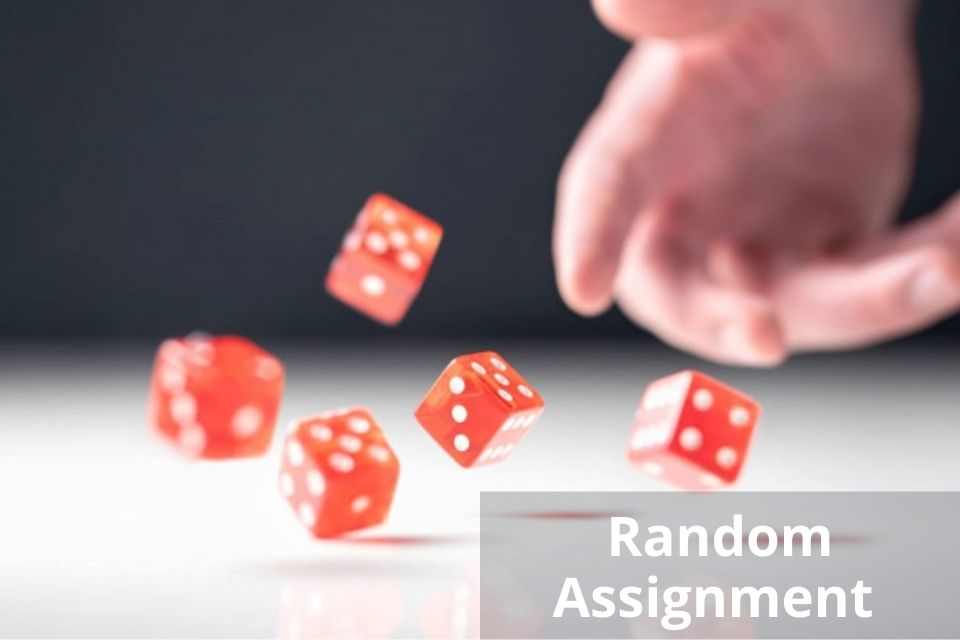Random Assignment in Experiments

Randomising participants’ placement into different treatment groups is termed a random assignment in experimental research.
Simple random assignment ensures that each participant of the controlled experiment has equal chances of being placed in either the experiment or the control group. Therefore, experimental studies that employ simple random assignment are also termed completely randomised designs.
Random assignment plays a vital role in experimental studies to ensure that the groups are comparable before the study starts and any differences that might occur between the groups are only a result of random factors.
What is the importance of random assignment?
Random assignment helps to enhance the internal validity of a study, and therefore its importance cannot be overlooked in experimental studies.
During experiments, researchers manipulate the independent variable and observe the changes and effects on the dependent variables. In contrast, the other variables are controlled to ensure they don’t interfere with the results. It can be done by using different levels of the independent variable for the different participant groups.
Such a design is called an independent measure design or between-groups.
Example of different levels of independent variables
A clinical study is conducted to investigate the effect of iron supplements in the diet on the body’s energy levels. In this case, the iron supplements’ effect is considered the independent variable while the energy level is the dependent one.
To experiment, researchers divide the participant into three groups, each receiving a different level of the independent variable:
- Control group: This group receives placebo doses.
- First experiment group: This group receives mild doses of iron supplements.
- Second experiment group: This group is administered heavy doses of iron supplements in their diet.
With the help of random assignment, researchers can eliminate the possibility of systematic and biased differences in the treatment groups.
Without random assignment, researchers would not be able to rule out any alternative explanations that they might find in their results.
Example of non-random assignment
While conducting the experimental study on the effects of iron supplements on energy levels, you use flyers to recruit participants for the study. You distributed the flyers in your local gym, coffee shop and shopping mall. After shortlisting the participants for your sample, a haphazard method was used to sort the participants into groups like;
- Heavy dosage group: This first group consists of participants recruited from the gym.
- Control Group: The second group consist of participants from the local coffee shop.
- Mild dosage group: The third group of the participant from the shopping mall.
If such an assignment is resorted to, it will be challenging to determine if the participant characteristics are uniform across all groups. For instance, participants from the gym might exhibit higher levels of energy due to their active habits. On the other hand, participants, from the mall, for instance, might display lower signs of energy levels, which can introduce a bias in your study.
If results point to high energy levels in the heavy dosage group, there would not be a way to ascertain if the results are solely impacted by the independent variable, i.e. iron supplement consumption or if the healthy lifestyle of the participants played a role in the conclusion.
Though, random assignment helps to level out the differences between the treatment groups; it cannot make them equivalent every time. Differences might arise from extraneous variables or simply by chance.
Random variation in most cases is low between the groups and is therefore acceptable, especially in the case of a large sample. To sum up, researchers should always use random assignment to form their treatment groups for the experimental study wherever it is possible, both ethically and sensibly.
How does random sampling differ from the random assignment?
Random sampling and random assignment are essential concepts in research studies; however, it is essential to understand the difference between them.
Random sampling finds used in several experimental studies; however, random assignment is used only for between-subjects experiments.
While some studies require the use of both random sampling and random assignment, some studies require the use of only one or the other.
Random sampling helps to make stronger statistical inferences as it helps to enhance the external validity of the study by ensuring an unbiased and representative sample of the population.
Example of random sampling
You are researching new interventions to boost employee engagement for a large organisation.
Since you have access to all the employees, you assign them a number and use a simple random sample for data collection. Then, using a random number generator, you choose 300 employees for your study.
It allows you to confidently infer that the results will be applicable for the rest of the employees since a random sample has been used to conduct the study.
Random assignment helps to eliminate systematic bias or differences among the treatment groups to enhance the study’s internal validity. In addition, it helps you to attribute the outcomes to the independent variable.
Example of random assignment
Your experimental design includes observing two treatment groups
These include the following:
- A control group: This is the treatment group that receives no intervention.
- An experimental group: This is the group that attends team-building interventions every week for a month.
Random assignment should be used to place the participants into the different treatment groups. This can be done by assigning each participant a number and using a random number generator to sort them out into either the control or the experiment group.
It allows you to confidently deduce whether employee engagement has been boosted by the team-building interventions or not and not as a result of any bias between the groups.
The different ways of using random assignment
There are several ways random assignment can be done. The most common is assigning participants a unique number and sorting them out into different treatment groups using a random number generator.
- Using a random number generator: A computer program can be used to generate random numbers from the list.
- Lottery: The unique numbers are all placed in a bucket or bowl and drawn out randomly to sort the participants.
- Coin flip: This is a viable option when there are only two treatment groups in a study. Flip a coin to determine which group the participant is put in.
This type of random assignment is quite powerful since it gives the participants an equal chance of being placed in either the control or the experimental groups.
Random assignment in block designs
In experimental designs that are more complicated, random assignment is used only after the participants are placed in specific blocks according to a characteristic trait. A larger sample is required for such grouping into blocks if you are looking to achieve high statistical power.
For instance, participants are placed into blocks based on a similar characteristic or trait, like graduate vs undergraduate students and then use random assignment within each block to sort participants for your treatment groups. This helps you conclude if the characteristics played a role in altering the study’s outcome.
In the case of experimental matched designs, you create predefined blocks and then match up the participants based on the characteristics for each block. Then, the participants can be randomly assigned to the different conditions in the experiment within each matching group or pair and compare the outcomes.
When to not use random assignment
There are some cases where random assignment is not ethical or relevant, and therefore the assignment of groups is done differently.
- When comparing different groups: Sometimes the main focus of an experimental study is to explore the differences between the participants. For example, comparing men and women with and without weight issues. In this case, participants are not assigned randomly to each treatment group and instead sorted out based on their condition.
- The independent variable, i.e. the gender, is the point of interest for the experiment in this study, and the treatment groups are characterised based on the different levels of impact weight has on their overall health. Finally, the treatment groups are treated equally, and the outcomes at a group level are compared.
- When it is not ethical: Random assignment cannot be used in experiments designed to study unhealthy or dangerous behaviours. For example, while conducting a study on heavy drinking vs social/recreational drinking, it would be highly unethical to ask participants of the experimental groups to consume a huge amount of alcohol just for the sake of your study.
- In such cases, when the random assignment of participants into groups is not possible, a quasi-experimental study can be conducted. Such type of experiment has you studying outcomes of previous experiments on pre-existing groups like heavy drinkers and social drinkers. These are not randomly assigned groups; however, they can be considered comparable when other extraneous variables are controlled like economic status, age, social status etc.
Frequently Asked Question
What is meant by random assignment?
Random assignment is the process of randomly sorting participants into treatment groups for an experimental study to eliminate any systematic bias or differences in the groups that might influence the outcome of the study.
How does random selection differ from the random assignment?
Random selection is the process of randomly selecting participants from a whole population for an experimental study, while the random assignment is the process of randomly placing the said participants into treatment groups to eliminate any difference between the groups.
When is a random assignment used?
Random assignment should always be used with independent measures or between-groups designs, consisting of a control group and one or more experimental groups.
How to randomly place participants into the different treatment groups?
Participants can be easily placed in groups with the help of random assignments. For example, each participant can be given a unique number, and a random number generator or lottery can be used to sort the participant into the respective groups. Other methods of random assignment can include a coin flip or a dice roll.
Total Assignment Help
Incase, you are looking for an opportunity to work from home and earn big money. TotalAssignmenthelp Affiliate program is the best choice for you.
Do visit :https://www.totalassignmenthelp.com/affiliate-program for more details
Total Assignment help is an online assignment help service available in 9 countries. Our local operations span across Australia, US, UK, South east Asia and the Middle East. With extensive experience in academic writing, Total assignment help has a strong track record delivering quality writing at a nominal price that meet the unique needs of students in our local markets.
We have specialized network of highly trained writers, who can provide best possible assignment help solution for all your needs. Next time you are looking for assignment help, make sure to give us a try.
Looking for Assignment Help from Top Experts ?
Get the best Assignment Help from leading experts from the field of academics with assured onetime, 100% plagiarism free and top Quality delivery.



